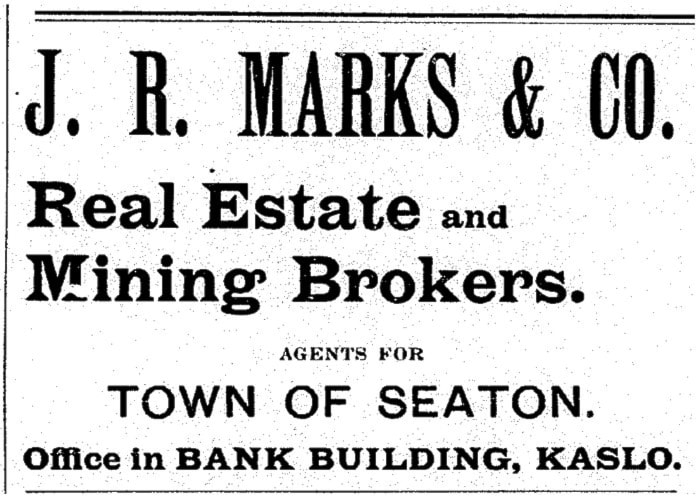West Kootenay is home to a dizzying number of ghost towns, drowned towns, and phantom townsites — the result of mining booms, dam construction, and real estate speculation.
For every famous place like Sandon, there are dozens of lesser-knowns. And then there are the really obscure ones. Here are five you won’t find discussed in any history book ...
SEATON
Highway 31A between Kaslo and New Denver is called the Valley of the Ghosts because it has so many lost towns, from Alamo to Zincton.
But until now, virtually no one knew about Seaton — named for the creek, in turn named for Jack Seaton, the prospector who with Eli Carpenter set off the Silvery Slocan rush.
The Nelson Tribune of April 6, 1893 reported: “The townsite of Seaton, located in the McGuigan basin near the Washington, Payne, and other noted Slocan mines, will be the next candidate for public favor offered to a real estate hungry world. General ‘Steve’ Bailey, the first man who had the nerve to invest capital in Slocan, it is understood, is the father of the enterprise. Tommy Roadley brought back a beautiful map of the townsite from Spokane and he will probably have the handling of the property.”
The Coeur d’Alene Miner of Wallace, Idaho added: “Seaton is a natural townsite, in the heart of the Slocan mining region. It is not more than a mile and a half distant from a dozen of the big mines of the district, such as the Noble Five group, Blue Bird, Robert E. Lee, Reco and others.”
J.R. Marks and Co. advertised itself as agent for Seaton lots through August, but otherwise the promotion never gained much momentum. Seaton’s precise location remains a mystery, although the phantom townsite plan should still be somewhere in the B.C. Land Titles office.
YODER
Name a place near Salmo that begins with Y and ends with R — besides Ymir. The answer is Yoder, whose existence is only confirmed because it had a post office in 1923-24.
Yoder was a short-lived sawmill adjoining Meadows Junction on the Great Northern Railway. Its namesake, Abner C. Yoder, was a representative of the Lindsley Bros. Pole Co. of Spokane, who came to Nakusp in 1906 and later lived and worked in Nelson.
The Nelson Daily News of April 12, 1923 quoted him saying “as soon as weather conditions permit, the operations at Meadows ... will be resumed on a large scale.” He was then buying machinery for the mill and expected to put 200 men to work.
However, by 1926, forest fires “ended the utility of the Meadows camp.” Lindsley Bros.’ Canadian division was liquidated and the A.C. Yoder Cedar Co. took its place. Yoder himself returned to Spokane sometime after 1936, and died there in 1960.
RHONDA BEACH
The 1911 census listed 35 people living at a place called Rhonda or Ronda, somewhere around Kaslo, including prominent families such as the Koehles, Shuttys, and Kemballs.
The Kootenaian of March 30 that year said “Capt. Richardson proposes to erect a handsome residence at The Cedars on Rhonda Beach,” which he would light with his own power plant. Other references said Andy Shutty was clearing 15 acres of fruit land on Rhonda Beach, a “rapidly growing settlement.”
However, the paper later gave Capt. Richardson’s address as Richardson’s Landing; the name Rhonda was never used again. On the face of it, it appears to have simply been the beach directly below Shutty Bench (a name that dates to 1909), but who was Rhonda?
CAMP WAMPSHA
 In April 1900, the King Solomon Mining Co. rolled out great plans for the Woodbury area along Kootenay Lake and applied for a post office to be called Wampsha. It never opened and the derivation of the name is a complete mystery, although a Google search finds a Native American woman named Wampasha who described a vision of heaven.
In April 1900, the King Solomon Mining Co. rolled out great plans for the Woodbury area along Kootenay Lake and applied for a post office to be called Wampsha. It never opened and the derivation of the name is a complete mystery, although a Google search finds a Native American woman named Wampasha who described a vision of heaven.
The company’s stationary read “Camp Wampsha, via Ainsworth, B.C.” and “Wampsha (Woodberry Creek), B.C.” (The creek has long been known by both spellings.)
By 1908, the company’s dreams were dashed, but their general manager, Dan Nellis, bought out their claims, office, boarding house, and concentrator. Newspapers periodically mentioned “D.H. Nellis of Camp Wampsha was in town,” until the final reference in 1913.
Nellis and his wife lived at the mouth of Woodbury Creek until his death in 1942.
PERKSVILLE
In 1893-94, the Nakusp Ledge carried several references to this curious Arrow Lakes town.
“Almost the entire population of Perksville, a thriving little hamlet at the lower end of the Narrows, came up last Thursday evening in charge of Commander J. Dawson,” the paper wrote.
They seemed to prefer travelling all together, for in another instance: “The population of Perksville came up en masse this week, under the restraining guidance of Mayor Perks.”
Who was this eponymous unelected leader? The paper said a J. Perks was ranching down the lake and that a Rev. Perks was conducting church services in Nakusp. The 1898 voters list also included a Nakusp hotelkeeper named John Vincent Perks — who later became secretary of the Victoria Golf Club. Were these all the same man? If not, which was the town’s namesake?
Perksville was probably an early name for Burton. Nothing more was heard of the former once the latter became a going concern in July 1894. Furthermore, one of the Burton brothers was once mentioned as departing for Perksville.
